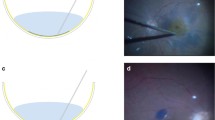Abstract
Background
Perfluorocarbon liquids (PFCLs) are used as intraoperative tools to stabilize the retina during vitreoretinal surgeries. Their use would be much facilitated if PFCLs were colored and not transparent. We describe the development of a colored PFCL for vitreoretinal surgeries.
Methods
Perfluorohexyloctan (F6H8) was colored by adding a blue, biocompatible anthraquinone dye, and then mixed with perfluorodecalin (PFD) or perfluorooctane (PFO) at different volume percentages. The thus-obtained colored PFCLs were incubated with lens, lens capsule, vitreous body, and retina of enucleated porcine eyes for staining purpose and analyzed microscopically. To analyze possible interactions between colored PFCLs and silicone oil, colored PFCLs were exchanged to BSS and silicone oil respectively in enucleated pig eyes.
Results
By mixing different volume% of colored F6H8 with perfluorodecalin (PFD) or perfluorooctane (PFO), colored PFCLs of different density and staining intensity were obtained. Cornea, lens, lens capsule, vitreous, and retina showed no signs of staining after incubation with colored PFCLs for 10 min. Colored PFCLs were transparent despite intense coloring, thus allowing a clear visibility of the underlying tissue. Immediately after instillation of silicone oil, the colored PFCL bubble was well-defined, and colored PFCL was easily aspirated. After 5 minutes reaction time, considerable diffusion of the dye from the PFCL bubble into the silicone oil was observed.
Conclusions
The staining intensity can be varied according to the volume% of the colored F6H8 phase. Colored PFCL is clearly visible when installed in the vitreous cavity of a pig eye, and can easily be removed. It does not stain the intraocular tissues in pig eyes. Colored PFCL can be exchanged with silicone oil. But a time-dependent diffusion of the dye into the silicone oil was observed in pig eyes, indicating that the contact should be limited.









Similar content being viewed by others
References
Chang S, Ozmet E, Zimmerman NJ (1988) Intraoperative perfuorocarbon liquids in the management of proliferative vitreoretinopathy. Am J Ophthalmol 106:668–674
Crafoord S, Larsson J, Hansson LJ, Carlsson JO, Stenkula S (1995) The use of perfuorocarbon liquids in vitreoretinal surgery. Acta Ophthalmol Scand 73:442–445
Comaratta MR, Chang S (1991) Perfuorocarbon liquids in the management of complicated retinal detachments. Curr Opin Ophthalmol 2:291–298
Velikay M, Stolba U, Wedrich A, Li Y, Datlinger P, Binder S (1995) The effect of chemical stability and purification of perfluorocarbon liquids in experimental extended-term vitreous substitution. Graefes Arch Clin Exp Ophthalmol 233:26–30
Veckeneer MA, de Voogd S, Lindstedt EW, Menz DH, van Meurs JC (2008) An epidemic of sticky silicone oil at the Rotterdam Eye Hospital. Patient review and chemical analyses. Graefes Arch Clin Exp Ophthalmol 246:917–922
Stappler T, Williams R, Gibran SK, Liazos E, Wong D (2008) A guide to the removal of heavy silicone oil. Br J Ophthalmol 92:844–847
Versura P, Cellini M, Torreggiani A, Bernabini B, Rossi A, Moretti M, Caramazza R (2001) The biocompatibility of silicone, fluorosilicone and perfluorocarbon liquids as vitreous tamponades. An unltrstructural and immunohistochemical study. Ophthalmologica 215:276–283
Mertens S, Bednarz J, Richard G, Engelmann K (2000) Effect of perfluorodecalin on human retinal pigment epithelium and human corneal endothelium in vitro. Graefes Arch Clin Exp Ophthalmol 238:181–185
Meinert H, Roy T (2000) Semifluorinated alkanes—a new class of compounds with outstanding properties for use in ophthalmology. Eur J Ophthalmol 10:189–197
Zeana D, Becker J, Kuckelkorn R, Kirchhof B (1999) Perfluorohexyloctane as a long-term vitreous tamponade in the experimental animal. Experimental perfluorohexyloctane substitution. Int Ophthalmol 23:17–24
Lepori L, Matteoli E, Spanedda A, Genovesi-Ebert F, Rizzo S (2006) Combined use of perfluorohexyloctane and silicone oil as intraocular tamponade: an in vitro study. Graefes Arch Clin Exp Ophthalmol 244:79–82
Mackiewicz J, Maaijwee K, Lűke C, Kociok N, Hiebl W, Meinert H, Joussen AM (2007) Effect of gravity in long-term vitreous tamponade: in vivo investigation using perfluorocarbon liquids and semi-fluorinated alkanes. Graefes Arch Clin Exp Ophthalmol 245:665–675
Kirchhof B, Wong D, Van Meurs J, Hilgers RD, Macek M, Lois N, Schrage NF (2002) Use of perfluorohexyloctane as a long-term internal tamponade agent in complicated retinal detachment surgery. Am J Ophthalmology 133:95–101
Author information
Authors and Affiliations
Corresponding author
Additional information
This article is original, and has not been published previously. The authors Rizzo, Belting, and Genovesi-Ebert have no commercial or financial interest related to this publication. Nadine Hagedorn is an employee of Fluoron GmbH. The authors transfer all copyright to the publisher upon acceptance. The authors have full control of all primary data, and they agree to allow Graefe’s Archive for Clinical and Experimental Ophthalmology to review their data upon request.
Rights and permissions
About this article
Cite this article
Rizzo, S., Belting, C., Genovesi-Ebert, F. et al. Colored perfluorocarbon liquids as novel intraoperative tools. Graefes Arch Clin Exp Ophthalmol 250, 653–659 (2012). https://doi.org/10.1007/s00417-011-1874-7
Received:
Revised:
Accepted:
Published:
Issue Date:
DOI: https://doi.org/10.1007/s00417-011-1874-7




